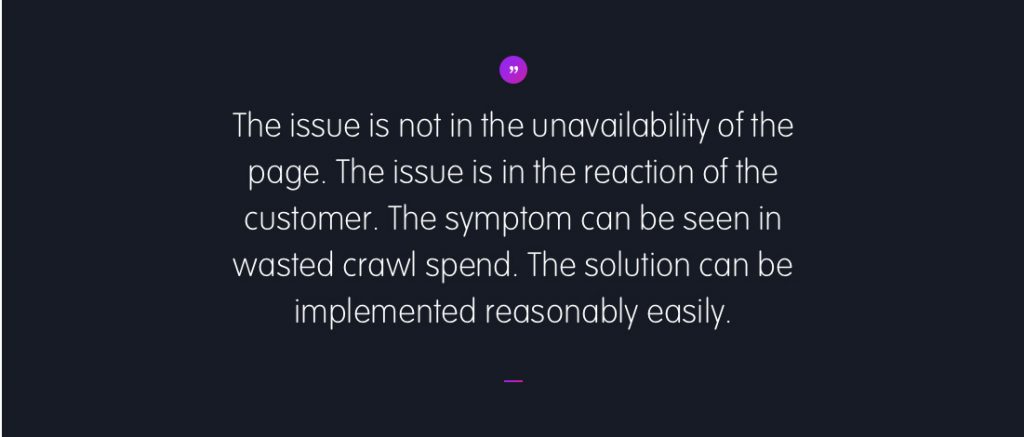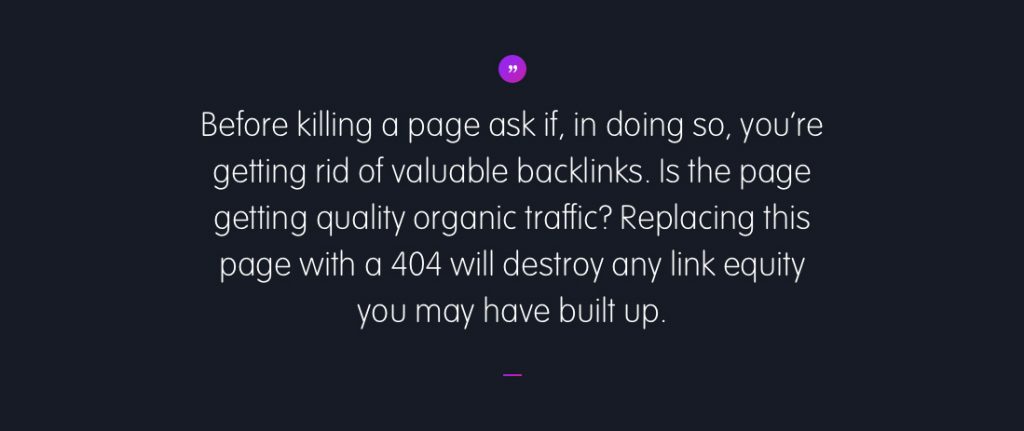In the sprawling realm of e-commerce, a seamless online shopping experience is pivotal. However, the digital landscape is riddled with potential pitfalls, and 404 errors are one such challenge that can deter customers and undermine SEO efforts.
If you have an eCommerce store with a large number of SKUs (thousands of SKUs), you have probably run into the issue dealing with expired stock and lines you no longer offer.
For many large volume retailers, the solution is usually as simple as a 404 Page Not Found alert. And while this is an easy fix for many, it’s probably the wrong fix if you’re looking for return business and more effective SEO spend.
The issue is not in the unavailability of the page. The issue is in the reaction of the customer. The symptom can be seen in wasted crawl spend. The solution can be implemented reasonably easily.
This blog post delves into the intricate relationship between SEO optimization and managing 404 errors on an e-commerce scale. Discover how strategic approaches can mitigate the impact of broken links, enhance user experience, and fortify your website’s search engine ranking. Join us on this journey of troubleshooting and optimisation, where your e-commerce success story unfolds.
Do 404s hurt your business?
Not directly. It’s not like Google sees a 404 and shoves you down the back of the queue. They do increase bounce rates. They can, if left for too long, hurt return business – no one wants to shop in a store that doesn’t ever have what they’re looking for. And they can affect your SEO efforts, wasting your spend and impacting your rankings.
Before we get to the dreaded 404s, let’s talk about SEO for large retail ecommerce sites and the challenge of fresh, relevant content, as this will help us set the scene for the 404 discussion.

You need to rank well for organic traffic.
It’s a challenge, especially when you need to look after your ranking while uploading hundreds of new products, creating new pages for new products and unpublishing old pages for old products. While a great system can make this less stressful, even the best system can fail when coping with a regular re-organisation on that scale.
One of the key SEO issues is in marketing like-for-like products.
For many of the retailers we have spoken to, there is a regular issue in getting all suppliers (especially the smaller ones) to provide all the content (including images and attributes) in time for the launch. Many times, the supplier is so focused on meeting their own deadline, they send the same content to multiple retailers. If you simply cut and paste their content, you run the risk of duplication with another retailer’s site, with the flow-on effect of downgrading your rankings.
The answer is in prioritising.
If you have a large product catalogue but are struggling to ensure they rank and sell well (and you have your core SEO bases covered) prioritising your best sellers is an easy way to approach both the SEO and the user experience for your products, helping you understand where you should focus your money, your effort and your time.
By prioritising what’s most important to your business – identifying your top performers and your bottom performers – you can more easily identify the products and categories you should put your SEO efforts into.
Create tiers.
A simple prioritisation plan can help you understand where to focus your SEO efforts and, therefore, your site management efforts.
Create three tiers.
- Tier 1: Your top 1-2% selling products, or products which you think you should be selling well – this can vary depending on category and your own understanding of your own site. Take the time to determine where your biggest sellers are and put them in the top tier.
- Tier 2: The next 5-10% products which should or do sell reasonably well
- Tier 3: The rest of your products which make up the bulk of your product range and sell occasionally
Your top tier takes priority.
Put your efforts where you’ll get the best bang for your SEO buck.
- Tier 1: Write custom product descriptions, take your own images, shoot original video content. This can be challenging for retailers who have 50-100,000 SKUs, as creating customer content, videos and imagery for the top 1% still means an investment in between 500 and 1,000 pages. But the returns from an SEO standpoint are worth it.
- Tier 2: Use supplier-provided imagery plus any additional product information you can gather quickly from the supplier and in your own research online
- Tier 3: Create custom meta and title tags, but use supplier-provided imagery and content
The mega-threat and how to meta-handle it.
With larger international online mega-retailers and marketplaces moving more and more into local markets, the challenge for local retailers is to find a way to beat them without being able to play the scale game.
Play to their weakness.
The weakness in these bigger sites is their size. The huge numbers of pages, and the size and speed of the site, presents huge issues for the retailer as there is a maximum number of pages google will crawl on any given day, so their challenge is getting their whole site regularly crawled.
The opportunity for smaller retailers (and this can still mean retailers with over 10,000 SKUs) is to ensure you have good on and off page SEO. Regular and good contact with search bots can put your site ahead in the rankings battle.
Use programmatic coding.
Programmatic SEO is a fantastic way to ensure you have appropriate and relevant meta-tags and titles.
Meta-tags are an SEO basic. But 350 new meta-tags a month, on top of an inventory of 15 to 20,000 SKUs, can be a huge challenge to do manually.
By creating a set of logical rules, through programmatic coding, you have greater confidence that your product page SEO is going to perform.
Invent the system that works for you.
Start by identifying the common logic behind each tag. This should be a simple set of rules which can easily be applied at all product lines. The simple use of variable fields then allows you to change the category and product names for each page.
For example:
You’re selling a Bright Red Fantastic Doowatsit, which is in the Widgets category. So your Title tag is going to looking something like this:
Bright Red Fantastic Doowatsit | Widgets
And your meta description might be something like this:
You can find all the best Widgets at our special Widget and Doowatch store including Bright Red Fantastic Doowatsit. Browse and shop online today.
So the rule logic for these two would look like
[Product Name] | [Category] and You can find all the best [Category] at our special Widget and Doowatch store including [Product Name]. Browse and shop online today.
As a starting point, this can be set up in an excel spreadsheet and handled manually as a single point of truth. Genuine time-saving benefits can be found by automating this process and coding it into your site. This will vary from retailer to retailer and site to site. It’s a challenge only your development team will be able to give you an answer to.

Meta-tags for better search
If a page is no longer available, and you don’t want it indexed, have your developers use an ‘unavailable_after’ tag. This is a simple piece of coding which can be implemented when the page is set up, and puts a precise time limit on the page visibility and lets Google know it should no longer index the page. It looks a little like this: <Meta Name=”Googlebot” Content=”unavailable_after: 20-Mar-2014 8:00:00 PST”>
Be out-of-stock, not out-of-consideration
Track your stock status in real time so customers can see when the product will be in stock and when they can purchase it. When you run out of stock, set up an “out-of-stock” default page.
Google sees ghosts
While a 404 message adds frustration to the client experience, it doesn’t get read by search bots. They’ll just be reading pages that aren’t there. And while this can’t directly hurt your SEO results, it can waste your crawl budget.
Do not unpublish a temporarily out of stock product.
As a rule, you want to avoid 404 error messages at all – it can put a real barrier in the mind of the visitor and serve as a mental redirect away from your site as well as hurting the SEO metrics google looks at such as bounce rates and dwell times.
The simplest way to avoid these is to have a default out of stock message in place which set up an acknowledgement of the potential frustration for the client (we don’t have your product at the moment) while still keeping them on the site and retaining them as a client.
Seasonal SEO meta-tags
If you’re in a seasonal business – like fashion – you can have whole categories that people don’t shop (and therefore justify a redirection of SEO funds) in certain seasons. Swimsuits in winter for example. If you want to keep a high value page, but don’t want it indexed in, say, winter, you can add a meta tag to noindex/follow the page. This will hide the page from search results. Visitors will still be able to reach the page through a bookmark, but a dynamic message on the page can be included if you believe this will be an issue. Come summer, just switch the meta-tag to index/follow.
Give them an option.
Have your development team set up a “closely-related item” function which can be applied across all SKUs. When a product becomes temporarily out-of-stock the customer should be presented with a list of potential options – which can further aid SEO functionality by creating additional internal page links – and the option to be notified once the item is back on the shelves.
Sometimes, the best strategy is to do nothing.
If a page is still generating traffic, or has evergreen content or information you know customers will find helpful (and allow you to add value which can count towards a future sale), try leaving it up but with a clear note (via dynamic messaging) that lets the visitor know the product is no longer available. It won’t generate a sale this time, but it may help generate a return visit and a sale next time.
If you must 404, do it with style
Sometimes a 404 can’t be avoided. If the 404 option is the best option you have, you want to reduce the bounce rate which 404s can generate. Consider creating a custom 404 page, explaining the lack of product (in a general sense – it’s usually unfeasible to create bespoke 404 pages for every SKU) and leaving the customer with a smile. The page can also provide options for alternative purchases, giving the customer more choices and giving you more chances to include key-words and links to other pages.

Don’t let it get to point of sale.
If the product is unavailable, tell them straight away.
Don’t let them shop for it, take it to the checkout and then tell them.
You usually find you’ve lost the sale. And probably the customer. And potentially at least ten of their friends.
Don’t kill backlinks.
Before killing a page ask if, in doing so, you’re getting rid of valuable backlinks. Is the page getting quality organic traffic? Replacing this page with a 404 will destroy any link equity you may have built up. If the product is only temporarily out-of-stock, offer the customer an alternative (and an apology) – or you can preserve the quality of the backlinks with a 301 redirect.
Take the 301 to Redirect-ville.
If one of your pages is receiving lots of organic traffic, and has lots of backlinks pointing in its direction, a 301 Redirect can let you keep the equity of page while not, technically, keeping the page.
Any page with backlinks should be 301ed.
As a rule, you should create a 301 Redirect for any discontinued stock pages that still have backlink value. This is also a superior choice for any out-of-stock pages – as long as you manage customer expectations regarding the re-direct with, as an example, a dynamic message.
This is not an automated function you’ll find on most CMSs, so you’ll need your developers to make it for you. Consider a breadcrumb with an automatic redirect to a relevant similar product or a new search in the relevant category. This can be complemented with dynamically-generated messages helping visitors understand the product is no longer available.

Too many 301s spoil the broth
Be warned. Having too many 301s can affect the performance of some servers, reducing site speed. Site speed is a ranking factor. If, once you’ve implemented your 301 Redirect strategy, your site speed slows, consider the Tiered system for your 301s, using backlinks and traffic numbers as metrics, and direct the other pages to a general 404.
When to say goodbye to old friends.
If the product is no longer available, and keeping reference to it on the site just adds an unnecessary barrier to your UX, (even for people who may want to know specifications or model information sometime in the future) or runs the risk of duplication (with a similar new product) and isn’t adding any value with backlinks, take it down – saying a silent prayer of thanks for the sales it generated while it was with you.
Want to talk about anything you’ve seen here?
If you want an SEO agency that will help you win the battle of the 404s, helping you retain traffic and reduce bounce rates, give us a Shout.

